This post is the second in a series of collaborative videos produced by ARES Researcher Ian McCollum, who also runs the Forgotten Weapons blog and YouTube channel. Using access to unique collections facilitated by ARES, this series of videos will examine a range of interesting weapons over the coming months. Each video will be accompanied by a blog post, here on The Hoplite, and supported by high quality reference photos. – Ed.
Ian McCollum & N.R. Jenzen-Jones
With the trend towards so-called ‘intermediate calibre’ cartridges following the second World War, several influential studies deemed the range requirements for contemporary infantry small arms to be substantially less than provided by earlier, ‘full-power’ rifle cartridges. In several reports – including the important Hall and Hitchman reports of the 1950s – ranges of no more than 300 m were anticipated for most infantry engagements. With increasingly responsive and accurate firepower, especially airpower, some later military thinkers envisaged the role of small arms further diminishing. In recent conflicts, particularly Afghanistan, however, infantry small arms have played a more pivotal role than was anticipated on a ‘modern’ battlefield. As one of the authors wrote in two of his recent reports:
“Traditional supporting fires—delivered by heavier weapon systems such as artillery and air-delivered munitions—were often restricted under rules of engagement or operational practices. Meanwhile, opposition forces have increasingly operated from within civilian communities, and military leadership and popular opinion have exhibited a lower tolerance for civilian casualties.”
As a result, infantrymen were frequently forced to engage enemies at longer ranges than anticipated, regularly beyond 300 m and often beyond the 500 m effective range of, for example the US Army’s M4-series standard rifle.
“US Army data suggests that more than 50 per cent of the small arms engagements in Afghanistan in 2011 required US Army forces to engage targets beyond 500 m. For their part, opposition forces would engage International Security Assistance Force (ISAF) units from ranges of up to 900 m or farther, employing full-power-calibre GPMGs and designated marksman rifles (DMRs).”
This threat ‘overmatch’ has been a driving factor behind the rapid adoption or increased issue of various full-power DMRs and GPMGs by several NATO and other forces, as well as an increased interest in so-called ‘general-purpose calibres’.
Different armed forces drew on existing stocks of GPGMs, in many cases, as well as purchasing new machine guns chambered for full-power rifle cartridges, such as the MK 48 as adopted by the US, and the FN Herstal Minimi in 7.62 × 51 mm adopted by the New Zealand Army.
These were supplemented by a number of DMR type weapons, with both modernised variants of available weapons, such as the US development of the MK 14 Enhanced Battle Rifle (EBR) series, and new weapon systems, such as the Australian acquisition of the Heckler & Koch HK417, seeing service.
The British acquisition of the L129A1 followed this same trend, with the British Ministry of Defence issuing a 2009 Urgent Operational Requirement for a self-loading ‘sharpshooter’ rifle “specifically to fill a need in Afghanistan“. The weapon was to be suitable both for use as a DMR, and in close-quarters battle (CQB) scenarios.
A number of manufacturers submitted rifles; after various testing stages, the final contenders for the role were the Heckler & Koch HK417 and the Lewis Machine & Tool LM7. LMT, partnered with Law Enforcement International (LEI) of the UK, eventually won the contract. Their offering was type classified as the L129A1 and formally adopted in October of 2009, with 440 L129A1 rifles purchased for some 1.5 million GBP. These entered field service by May 2010, and subsequent purchases have since been made.
LMT and LEI partnered to enter the LM7, the export version of LMT’s LM308MWS, into the sharpshooter trials programme. This is essentially an SR-25 type self-loading rifle, using the original Stoner quasi-direct-impingement action and a multi-lug rotating bolt. Original guns, acquired under the UOR, were built on machined billet receivers. Later guns have been built around the LMT Monolithic Rail Platform, a one-piece upper receiver milled from a single 7075 T6 aircraft aluminium forging. The weapon’s case deflector has been through three iterations. With the billet receiver guns, a lat-topped ‘bump’ shape was machined and added. This was then adjusted to a forged design, before a customer requirement in advance of the 2012 Olympics was met by modifying the design so that it deflects ejected cartridge cases out at the two o’clock position instead of a typical three o’clock position as is standard on the LM308MWS. According to one industry source, this was so that the L129A1 could be better used from helicopter platforms, such as was seen during the 2012 London Olympics. The concern was that brass ejected at a traditional position would be more likely to fall back into the helicopter and create a safety hazard for the crew. As part of LMT’s Modular Weapon System (MWS) family, the L129A1 features a 16” heavy stainless steel barrel which can be quickly swapped out. LMT produces compatible barrels in 13.5, 16, 18, and 20 inch lengths.
The internal components are similarly high quality. As Chris Bartocci notes:
“In keeping with the original AR-10 design, the bolt and bolt carrier are chrome-plated. Chrome is much easier to clean than most finishes, is corrosion-resistant and has self-lubricating properties. The rifle uses an H3 buffer with three tungsten weights. The bolt carrier has a captive firing pin retainer pin—a major plus when cleaning a rifle in the desert. A cotter pin is easy to lose in the sand, and this design prevents that. The bolt, like the barrel, is test-fired with a proof cartridge, magnetic-particle-inspected and marked “MP” to indicate the testing was done. Also, Lewis improved the hammer/trigger pins by incorporating a swell on one end, making them easier to remove.”
The rifle is issued in British service with a Trijicon TA648-308 6 x 48 mm (ACOG) illuminated optic for precision engagements. The ACOG is fitted with a Picatinny rail to which is mounted a Trijicon RM01 1 x Ruggedized Miniature Reflex (RMR) for CQB use. The L129A1 is fitted with a two-stage match trigger with a 4 lb trigger pull.
Unlike some similar programmes in the US, the British requirement was for the Sharpshooter rifle to fire standard 7.62 x 51 L2A2 ball ammunition produced in the UK at Royal Ordnance Factory Radway Green (RG). According to Greg Felton from LEI:
“The ammunition criteria stated by the MOD was that the rifle was to be able to use both RG 155-grain sniper ammunition, plus M80 ball and tracer, including de-linked machine gun belts. In the end during their trials with the various competitors, they found that the 155-grain fired so much better than the standard ball that it was made the official issue ammunition for the weapon. As to what it is “matched to,” [Karl & I] designed the rifle to use both standard ball and 168-grain Match. With a 1:11.25 inch twist it works well with these weights, however, the heavier 175-grain projectiles need a faster twist for best results at longer ranges.”
The L129A1 was issued at that section level in the British Army, with one soldier in eight carrying the rifle. Three soldiers per section would be trained on the rifle, should they need to take over its operation. The moderately high weight of the gun and the good field of view of the optic contribute to making the L129A1 well-suited to rapid follow-up shots, a key performance characteristic in the DMR role. It has proven effective and popular amongst British forces. One British soldier who spoke to ARES about the weapon described it as “comfortable and easy to shoot”. During our brief time on the gun, we found that to be true. The LM308MWS, on which the L129A1 is based, is also in service with other military and law enforcement customers.
The British Army is currently looking to expand the role of the L129A1, considering issuing it as a sniper support weapon. However, this would involve a change in anticipated targets to include enemies wearing modern body armour, which the current 7.62 x 51 mm ball projectiles are not particularly good at defeating at longer ranges. A new projectile with a mild steel penetrator core (in principle similar to the 5.56 x 45 mm SS109 projectile) – but with ballistics matching the ball cartridges already in service – has been developed to allow the L129A1 to fill this new role if desired.
Technical Specifications
Calibre: 7.62 x 51 mm
Overall length (stock extended): 990.6 mm
Overall length (stock collapsed): 901.7 mm
Barrel length: 406 mm (16”)
Weight (unloaded): 4.50 kg
Feed device: 20-round detachable box magazine
Special thanks to the Defence Academy of the United Kingdom at Shrivenham, for allowing us to handle and fire a L19A1 rifle, and to Neil Grant. All images copyright Armament Research Services, except ACOG/reticle image (copyright Dan Shea/Small Arms Review).
Gallery 1 – L129A1
Gallery 2 – Heckler & Koch HK417 and FN Herstal MK 17 Mod. 0 (trials rifles)
Remember, all arms and munitions are dangerous. Treat all firearms as if they are loaded, and all munitions as if they are live, until you have personally confirmed otherwise. If you do not have specialist knowledge, never assume that arms or munitions are safe to handle until they have been inspected by a subject matter specialist. You should not approach, handle, move, operate, or modify arms and munitions unless explicitly trained to do so. If you encounter any unexploded ordnance (UXO) or explosive remnants of war (ERW), always remember the ‘ARMS’ acronym:
AVOID the area
RECORD all relevant information
MARK the area to warn others
SEEK assistance from the relevant authorities

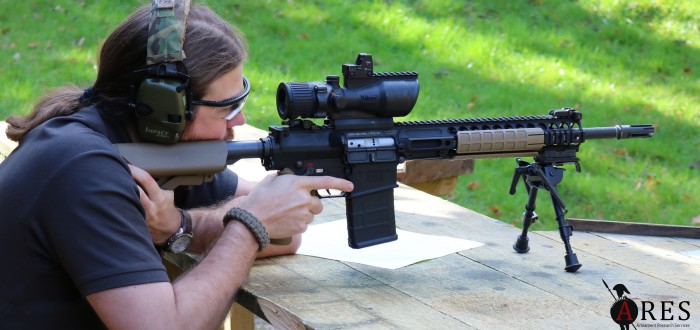

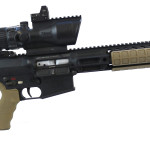





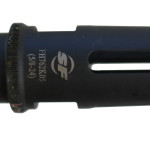


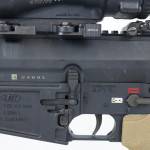






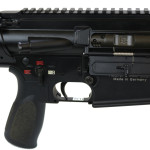

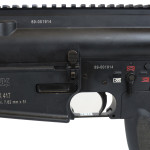
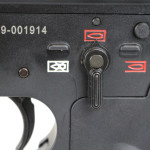
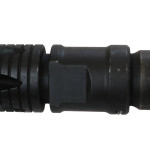
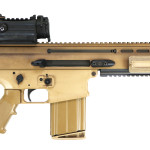
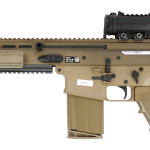


4 thoughts on “British L129A1 sharpshooter rifle”